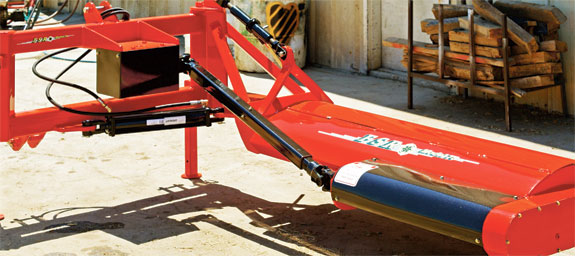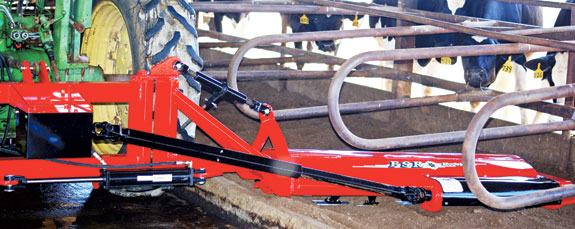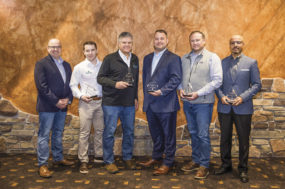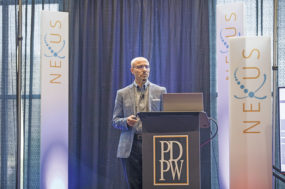Moisture can be a real problem in freestalls bedded with manure solids. It aids the growth of bacteria, which can lead to herd health issues. Raking freestalls bedded with manure solids is a common practice to combat the moisture, but many times it just scratches the surface. Looking for a better way, dairyman Mark Barroso of Merced, California, designed and built the Freestall Rototiller. Unlike other rototillers, this one runs off the PTO of a small- to mid-sized tractor that can provide 60 to 100 horsepower.
“It’s a hard pulling tool, especially the first time it’s used,” Barroso says, noting horsepower towards the top of the range may be needed on beds that have never been tilled.
The PTO turns the gearboxes, which rotate shafts of sharpened plow steel blades. The blades dig in and turn up bedding all along the length of the rototiller, which can be sized to fit any stall.
Of the units he’s built, they have ranged from 67 inches of cutter head to 57 inches for a Jersey farm with shorter stalls.

It is equipped with a breakaway clutch. Should anything get hung up in the rototiller, it stops the unit. It also has a shield for added prevention of rocks and metal entering the machine.
Barroso uses the rototiller a couple of times a week on his 700-cow dairy.
“With us, it’s made a big difference,” he says. “We were having a lot of problems with somatic cell counts, averaging 200,000 per month. Those were just high counts for us.”
Now, with the rototiller, Barroso reports the dairy’s SCC is 50,000 to 75,000, which is very low for the area.
In addition, less bedding is needed in the barns. He only beds his cows every five to six weeks.
“Guys who use the rake tend to bed cows more often,” he says. By tilling it, the bedding stays drier and can stay in the stall longer. He believes it also digs in deeper than a rake, softening bedding deep below the curb. When it’s real soft down below, Barroso says it helps hold the bedding together versus cows sweeping the soft stuff off of a hardened surface.

With less bedding used, fewer solids are settling in his ponds – something he found others have noticed too.
“One dairyman told me with the money he’s saved in excavating his holding ponds, the unit has paid for itself more than once,” Barroso claims.
It seems the cows are also pleased with the performance of the rototiller. He estimates his herd tends to lie down in the stalls 20 to 30 percent more than before.
“We can make a pass, and the cows will come to lay down right behind it,” Barroso says.
Tony Machado estimates his 3,100-cow herd is getting 15 percent more usage of the stalls versus the exercise lots since he started using the rototiller a year ago.
Farming in Merced for nearly 40 years, Machado uses dried manure scrapings from the corral for bedding. The barns are flushed, adding even more moisture to the stalls when the cows walk in from a wet alley. The freestalls are raked daily and rototilled once a week.
He says he’s used other tillers, but those all ran with hydraulics from a skid loader. He really likes the fact this unit is powered by a tractor instead.
The rototiller allows him to multipurpose an existing tractor at his dairy, instead of investing in two pieces of equipment.
“It’s just $9,700 for [the rototiller] versus $40,000 to $50,000 in a Bobcat,” says Machado, who doesn’t have a skid loader on his dairy. “This is more economical for me.”
After trying Barroso’s unit for just one week, he decided to order one for himself.
Machado says he likes this unit because it is real manageable going into the freestall and it moves very fast. The depth can be adjusted, and he sets it at 4 inches. It can also be propped at an angle to leave the bedding a little higher towards the front of the stalls.
“It makes a real soft mattress for the cows to sleep on,” he says.
Plus, in the past year, he found it to be low maintenance. “Aside from greasing the gear box, there isn’t much to it,” he says. Machado did change the blades once, but mentions the project was affordable.
As to whether his money was well spent, Machado says, “There’s no money you can put on cow comfort.” By keeping cows comfortable, it lowers SCC and incidences of mastitis, among other things, he says.
“I think I paid it back in one year,” he adds. “The cows are lying in the freestalls better.”
The only thing he’d change is to have it run off a smaller tractor with less horsepower, but Machado says he is not sure that is even possible. PD
To view the rototiller in action, go to www.freestallrototiller.com . For questions about the product or its availability, contact Mark Barroso at mark@freestallrototiller.com or (209) 652-6424.
The following checklist can be used to determine if this new technology might be a fit for your operation.
1. Would you like to increase cow comfort?
2. Are you interested in lowering your somatic cell count?
3. Do you have a problem with moisture in your freestalls?
4. Do you use manure solids for bedding?
5. Is a flush system adding extra moisture to the stalls?
6. Do you have time once a week to make an extra pass through the stalls?
7. Do you own a tractor with 60 to 100 horsepower?
8. Would you want fewer solids in your lagoons?
If you answered yes to six or more of these questions, this technology may be one for you to consider.

-
Karen Lee
- Midwest Editor
- Email Karen Lee







